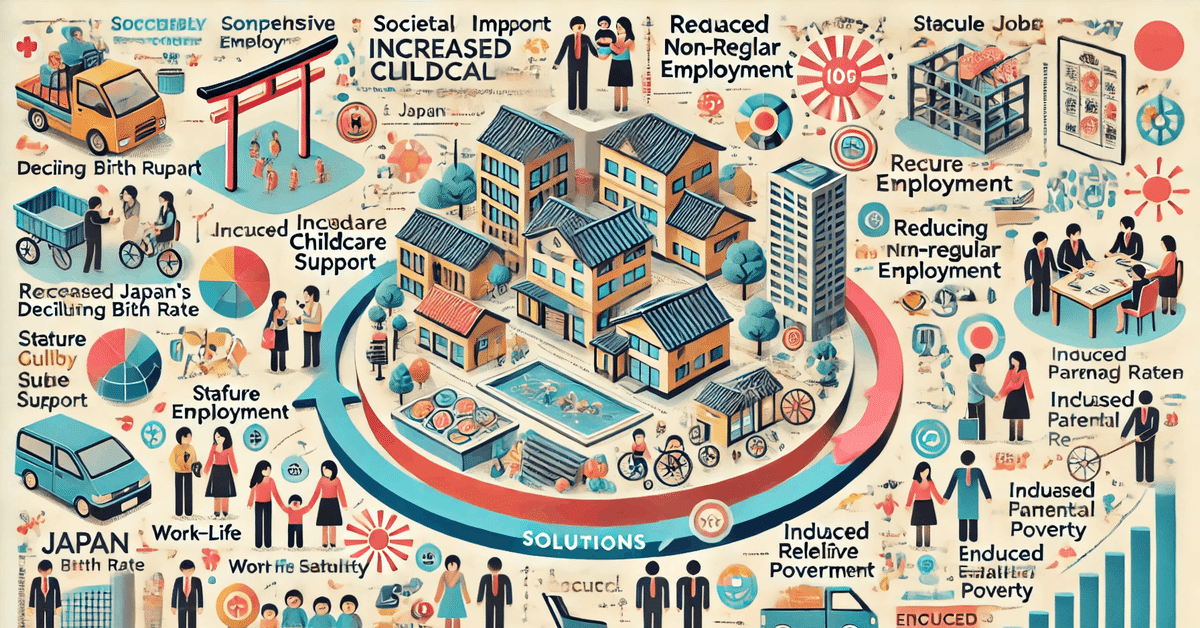
【第4話:Episode 4】 少子化対策と出生率の未来:Addressing the Declining Birthrate and the Future of Japan’s Birthrate
こんにちは、Tommy Yoshidaです。
日本が直面している最大の課題の一つが少子化です。人口の減少は社会全体に深刻な影響を与え、経済成長の鈍化や社会保障制度の維持が難しくなるなど、未来にわたる問題となります。本記事では、少子化が社会に与える影響と、その対策としてAIが提案する具体的な方法について議論します。さらに、若者たちが自然に子供を持つ意識を育むための具体策についても考察します。
少子化の現状と社会への影響
現在、日本の出生率は低迷しており、人口減少が進行しています。出生率の低下は、労働力の減少や消費の低下、税収の減少を引き起こし、経済の停滞を招きます。また、高齢化が進むことで医療や介護の負担が増加し、社会保障制度の維持が困難になる可能性があります。
AIの解析によると、2024年を境に日本は大きな分岐点を迎えます。ここでの選択が未来の日本を大きく変える可能性があります。少子化問題に対して早急な対策を講じることが、未来の豊かさを決定づける鍵となります。
AIが提案する少子化対策
AIの解析結果から、出生率を向上させるための具体的な対策として以下の方法が示されています。
子育て支援の拡充: 保育士の数を増やし、保育施設の整備を進めることが重要です。また、子供の学習費用の自己負担を軽減することも、経済的な不安を和らげる効果があります。
非正規雇用の減少: 非正規雇用の割合を減らし、安定した雇用環境を提供することで、若者が将来に対する不安を感じずに結婚や出産を選択できるようにすることが必要です。
婚姻率の上昇: 若者の婚姻率を上げるためには、相対的貧困率を下げることが重要です。経済的な安定が確保されることで、結婚を前向きに考える人が増えるでしょう。
若者たちに子供を持とうという意識が自然に育つための具体策
ワークライフバランスの推進: 長時間労働を是正し、柔軟な働き方を推進することが重要です。テレワークやフレックスタイム制度を導入し、育児と仕事の両立を支援する環境を整えることで、若者が子育てに対する不安を減らすことができます。
育児休業制度の充実: 男性の育児休業取得率を向上させるための制度改革を行い、育児を家庭全体で分担できる環境を整えることが必要です。これにより、女性のキャリア継続が容易になり、家庭全体で子育てに取り組む意識が自然に育まれます。
住環境の改善: 子育て世代が住みやすい住環境を整備することも重要です。公園や子育て支援施設の充実、交通の利便性向上など、安心して子供を育てられる環境を提供することで、若者が子供を持つことに対する不安を解消します。
経済的支援の拡充: 子育てにかかる経済的負担を軽減するための支援策を強化します。例えば、児童手当の増額や学費の無償化、住宅購入支援など、具体的な経済的支援を提供することで、若者が安心して子供を持つことができる環境を整えます。
教育と啓発活動: 子育ての重要性や喜びについて教育し、啓発活動を行うことも効果的です。学校やコミュニティでのプログラムを通じて、子育てに対する前向きな意識を育てることができます。
成功事例から学ぶ
世界の成功事例を見ても、これらの対策が効果的であることが示されています。例えば、フランスでは充実した子育て支援策により、出生率が改善しています。また、ドイツでは非正規雇用の減少により、安定した雇用環境が整備され、若者の結婚率が上昇しました。
これらの成功事例から学び、日本でも同様の対策を実施することで、少子化問題に対処することが可能です。具体的には、政府と民間が連携し、効果的な政策を推進することが求められます。
少子化対策の未来
AIの解析結果によると、今後の少子化対策は効果的に実施されれば、出生率は1.1倍から最大で1.3倍以上に向上する可能性があります。これにより、社会全体の活力が増し、経済の成長も期待できます。
また、労働環境の改善や育児支援の充実により、働きながら子育てをすることができる社会の実現も重要です。これにより、女性の社会進出が進み、経済全体の活力がさらに高まるでしょう。
まとめ
少子化は日本社会にとって避けて通れない課題です。しかし、AIの解析結果や成功事例から学ぶことで、効果的な対策を講じることが可能です。子育て支援の拡充、非正規雇用の減少、婚姻率の上昇といった具体的な政策を実施し、若者たちが自然に子供を持とうという意識を育む社会を実現しましょう。未来の豊かな日本を実現するために、私たち一人ひとりが積極的に行動することが求められます。
これからの日本のために、少子化対策を真剣に考え、実行に移していきましょう。次回は、WEB3・AIを実装すべき分野具体的手法について議論します。お楽しみに。
以上が第4話の内容です。少子化問題に対する具体的な対策とその未来について、AIの解析結果を基に考察しました。次回もお楽しみにお待ちください。
Episode 4: Addressing the Declining Birthrate and the Future of Japan’s Birthrate
Hello, this is Tommy Yoshida.
One of the most significant challenges Japan faces today is its declining birthrate. The population decline profoundly impacts society, leading to economic stagnation and difficulties in maintaining social security systems, among other long-term issues. In this article, we will discuss the effects of the declining birthrate on society and explore specific measures proposed by AI to address this issue. Additionally, we will consider concrete strategies to foster a society where young people naturally develop the mindset of having children.
The Current Situation of the Declining Birthrate and Its Impact on Society
Currently, Japan's birthrate is low, and the population is decreasing. This decline leads to a reduction in the workforce, decreased consumption, and lower tax revenues, resulting in economic stagnation. Additionally, an aging population increases the burden on healthcare and caregiving, making it challenging to sustain the social security system.
According to AI analysis, Japan is approaching a critical turning point in 2024. The choices made at this juncture could significantly alter Japan's future. Addressing the declining birthrate promptly is crucial to ensuring a prosperous future.
AI-Proposed Measures to Address the Declining Birthrate
The AI analysis suggests several specific measures to improve the birthrate:
Enhancing Childcare Support: Increasing the number of childcare workers and expanding childcare facilities are essential. Additionally, reducing the self-financed cost of children's educational expenses can alleviate financial anxiety.
Reducing Non-Regular Employment: Decreasing the proportion of non-regular employment and providing stable employment environments are necessary. This ensures that young people can choose marriage and childbirth without future uncertainties.
Increasing Marriage Rates: Lowering the relative poverty rate is crucial to increasing marriage rates among young people. Economic stability enables more people to consider marriage positively.
Concrete Strategies to Foster a Mindset Among Young People to Have Children
Promoting Work-Life Balance: Correcting long working hours and promoting flexible working styles are important. Introducing telework and flextime systems can support a balance between work and childcare, reducing anxiety about raising children.
Enhancing Parental Leave Systems: Reforming systems to improve the rate of men taking parental leave and creating an environment where childcare responsibilities can be shared within the family are necessary. This allows women to continue their careers and fosters a family-oriented approach to childcare.
Improving Living Environments: Ensuring that environments where families with children can live comfortably is also important. Providing well-maintained parks, child support facilities, and improving transportation convenience can alleviate anxieties about raising children.
Expanding Financial Support: Strengthening support measures to reduce the financial burden of childcare is crucial. For instance, increasing child allowances, making educational expenses free, and providing housing purchase support can create an environment where young people can comfortably have children.
Education and Awareness Campaigns: Educating about the importance and joy of parenting and conducting awareness campaigns can also be effective. Programs in schools and communities can foster a positive mindset toward parenting.
Learning from Successful Examples
Looking at successful examples worldwide, these measures have proven effective. For example, France has improved its birthrate through comprehensive childcare support. Additionally, Germany has seen a rise in marriage rates among young people by reducing non-regular employment and establishing a stable employment environment.
By learning from these successful examples, Japan can implement similar measures to address the declining birthrate issue. Specifically, collaboration between the government and private sector is necessary to promote effective policies.
The Future of Measures to Address the Declining Birthrate
According to AI analysis, effectively implementing measures to address the declining birthrate could improve the birthrate by 1.1 to a maximum of 1.3 times. This would enhance the overall vitality of society and contribute to economic growth.
Moreover, improving working conditions and enhancing childcare support are crucial for realizing a society where people can work and raise children simultaneously. This would also promote women's social participation, further boosting economic vitality.
Conclusion
The declining birthrate is an unavoidable challenge for Japanese society. However, by learning from AI analysis and successful examples, we can implement effective measures. Expanding childcare support, reducing non-regular employment, and increasing marriage rates are concrete policies that can help create a society where young people naturally develop the mindset of having children. To ensure a prosperous future for Japan, we must all actively engage in addressing the declining birthrate issue.
Let’s seriously consider and implement measures to address the declining birthrate for Japan’s future. In the next episode, we will discuss specific methods for implementing WEB3 and AI in various fields. Stay tuned.
#少子化対策 #出生率向上 #日本の未来 #DecliningBirthrate #IncreaseBirthrate #FutureOfJapan
この記事が気に入ったらサポートをしてみませんか?
